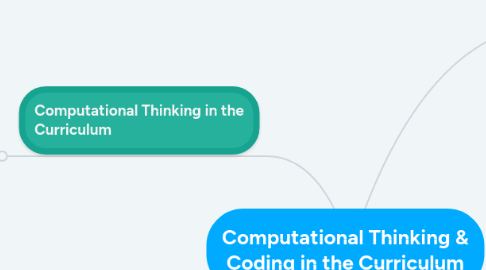
1. Computational Thinking in the Curriculum
1.1. Digital Technologies
1.1.1. A problem-solving method that involves various techniques and strategies that can be implemented by digital systems. Techniques and strategies may include organising data logically, breaking down problems into parts, defining abstract concepts and designing and using algorithms, patterns and models.
1.1.2. Use computational thinking and the key concepts of abstraction; data collection, representation and interpretation; specification, algorithms and implementation to create digital solutions
2. Foundation - Year 2
2.1. Coding
2.1.1. By the end of Year 2, students will have had opportunities to create a range of digital solutions through guided play and integrated learning, such as using robotic toys to navigate a map or recording science data with software applications.
2.2. Computational Thinking
2.2.1. In Foundation – Year 2, students begin to learn about common digital systems and patterns that exist within data they collect. Students organise, manipulate and present this data, including numerical, categorical, text, image, audio and video data, in creative ways to create meaning. Students use the concept of abstraction when defining problems, to identify the most important information, such as the significant steps involved in making a sandwich.
3. Year 3 & 4
3.1. Coding
3.1.1. By the end of Year 4, students will have had opportunities to create a range of digital solutions, such as interactive adventures that involve user choice, modelling simplified real world systems and simple guessing games
3.2. Computational Thinking
3.2.1. In Year 3 and 4, students explore digital systems in terms of their components, and peripheral devices such as digital microscopes, cameras and interactive whiteboards. They collect, manipulate and interpret data, developing an understanding of the characteristics of data and their representation
4. What is coding?
4.1. Coding is the ability to create a computer algorithm that makes it possible to create websites, computer software and apps
4.2. Coding is referred to as the 'computer language' as what we input/output tells the computer what to do
5. What is computational thinking?
5.1. Computational thinking is a strategy that involves understanding the problem in order to solve it. This way of thinking is broken into four parts;
5.1.1. decomposition
5.1.1.1. Solving a problem by breaking it down into smaller parts and understanding what all the parts are
5.1.2. pattern recognition
5.1.2.1. Looking within problems to find similarities/differences or matching patterns
5.1.3. abstraction
5.1.3.1. focusing on the relevant information that is important within the problem and dismissing irrelevant information
5.1.4. algorithms
5.1.4.1. developing either a step-by-step solution that allows the problem to be solved
5.1.4.2. following the exact rules given to solve the problem
5.2. Computational thinking does not apply just to Technologies, it can be used across the curriculum to assist in problem solving in areas such as mathematics, humanities and social science
6. Year 5 & 6
6.1. Coding
6.1.1. By the end of Year 6, students will have had opportunities to create a range of digital solutions, such as games or quizzes and interactive stories and animations
6.2. Computational thinking
6.2.1. In Year 5 and 6, students develop an understanding of the role individual components of digital systems play in the processing and representation of data. They acquire, validate, interpret, track and manage various types of data and are introduced to the concept of data states in digital systems and how data are transferred between systems
